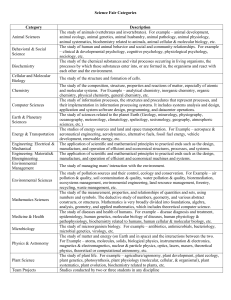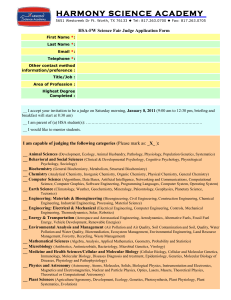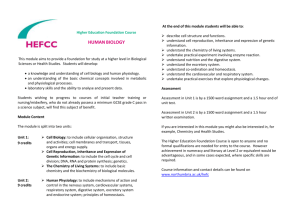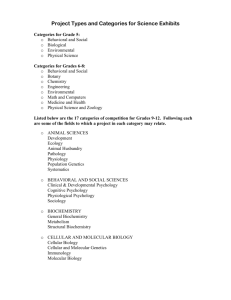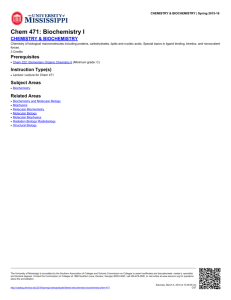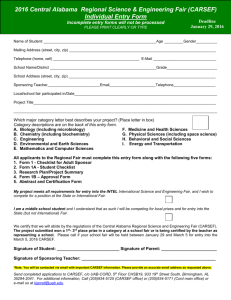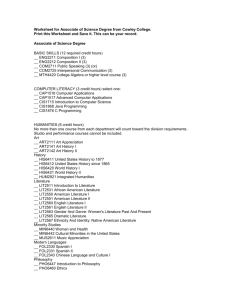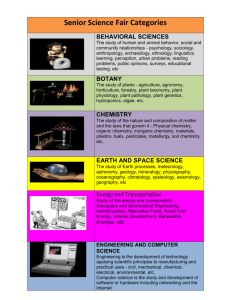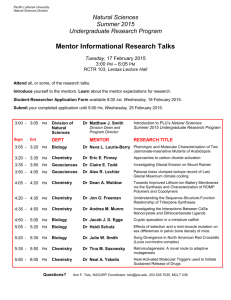Due Date: Name: Science Category Experiments Date: Period
advertisement
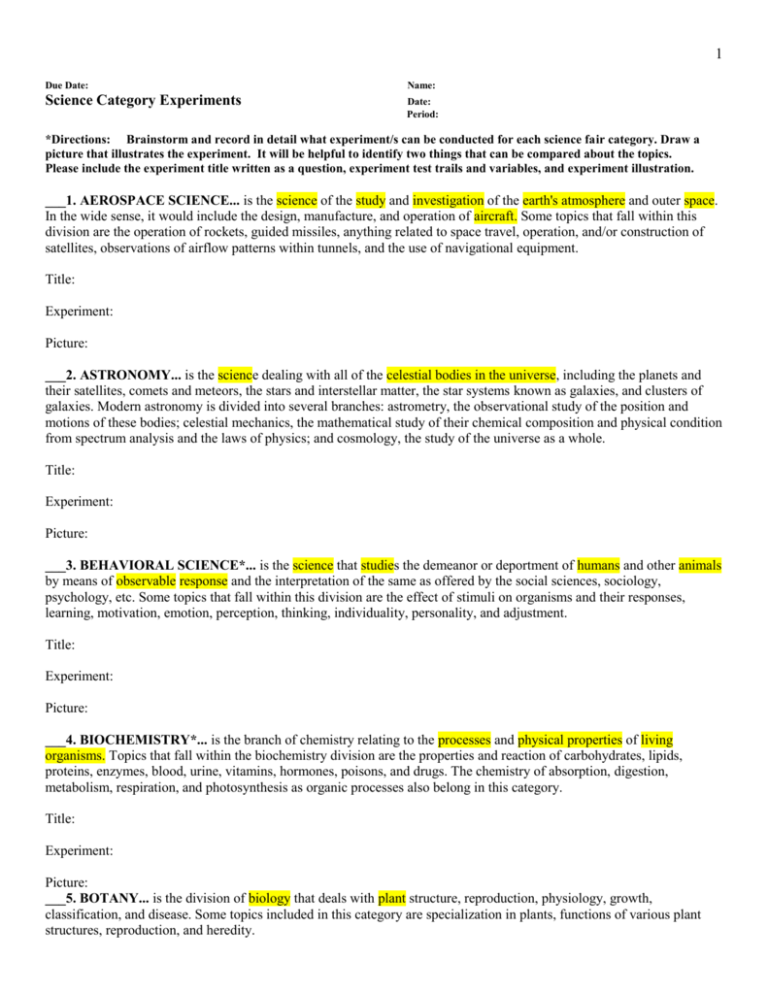
1 Due Date: Name: Science Category Experiments Date: Period: *Directions: Brainstorm and record in detail what experiment/s can be conducted for each science fair category. Draw a picture that illustrates the experiment. It will be helpful to identify two things that can be compared about the topics. Please include the experiment title written as a question, experiment test trails and variables, and experiment illustration. ___1. AEROSPACE SCIENCE... is the science of the study and investigation of the earth's atmosphere and outer space. In the wide sense, it would include the design, manufacture, and operation of aircraft. Some topics that fall within this division are the operation of rockets, guided missiles, anything related to space travel, operation, and/or construction of satellites, observations of airflow patterns within tunnels, and the use of navigational equipment. Title: Experiment: Picture: ___2. ASTRONOMY... is the science dealing with all of the celestial bodies in the universe, including the planets and their satellites, comets and meteors, the stars and interstellar matter, the star systems known as galaxies, and clusters of galaxies. Modern astronomy is divided into several branches: astrometry, the observational study of the position and motions of these bodies; celestial mechanics, the mathematical study of their chemical composition and physical condition from spectrum analysis and the laws of physics; and cosmology, the study of the universe as a whole. Title: Experiment: Picture: ___3. BEHAVIORAL SCIENCE*... is the science that studies the demeanor or deportment of humans and other animals by means of observable response and the interpretation of the same as offered by the social sciences, sociology, psychology, etc. Some topics that fall within this division are the effect of stimuli on organisms and their responses, learning, motivation, emotion, perception, thinking, individuality, personality, and adjustment. Title: Experiment: Picture: ___4. BIOCHEMISTRY*... is the branch of chemistry relating to the processes and physical properties of living organisms. Topics that fall within the biochemistry division are the properties and reaction of carbohydrates, lipids, proteins, enzymes, blood, urine, vitamins, hormones, poisons, and drugs. The chemistry of absorption, digestion, metabolism, respiration, and photosynthesis as organic processes also belong in this category. Title: Experiment: Picture: ___5. BOTANY... is the division of biology that deals with plant structure, reproduction, physiology, growth, classification, and disease. Some topics included in this category are specialization in plants, functions of various plant structures, reproduction, and heredity. 2 Title: Experiment: Picture: ___6. CELLULAR & MOLECULAR BIOLOGY*… is the study of the organization and functioning of the individual cell; molecular genetics focusing on the structure and function of genes at a molecular level. Other topics may include the structure and function of the immune system, innate and acquired immunity, and the interaction of antigens with antibodies. Molecular biology concerns itself with understanding the interactions between the various systems of a cell, including the interrelationships of DNA, RNA and protein synthesis and learning how these interactions are regulated. Title: Experiment: Picture: ___7. CHEMISTRY... is the science that deals with the structure, composition, and properties of substances and of their transformations. Some topics included in this category are the composition of various compounds, the formulation of various compounds, the study of gas laws, atomic theory, ionization theory, and the analysis of organic and inorganic products. Title: Experiment: Picture: ___8. COMPUTER SCIENCE... includes the study and development of computer hardware, software engineering, Internet net working and communications, graphics (including human interface), simulations/virtual reality or computational science (including data structures, encryption, coding, and information theory). Topics in this category may include writing an original program and comparing it to an existing one, developing a new language and comparing it to an existing one, etc.4 Title: Experiment: Picture: ___9. CONSUMER SCIENCE*... is the study of comparisons and evaluations of manufactured or commercial products. Topics included in this category are taste tests, color preferences, quality control, and product efficiency. Title: Experiment: Picture ___10. EARTH SCIENCE... is the science concerned with the origin, structure, composition and other physical features of the earth. Some topics that fall within this division are geology (earth composition, rock formation, fossils, minerals, and fossil fuel); geography (landforms, soils, classification of streams, erosion, and sedimentation); oceanography (ocean 3 waves, ocean currents, composition of ocean water and coastal zone management); seismology; geophysics; and meteorology. Title: Experiment: Picture: ___11. ELECTRONICS... is the branch of engineering and technology that deals with the manufacture of devices such as radios, television sets, and computers that contain electron tubes, transistors, chips, or related components. Topics in this category are circuits (electrical, electric digital and analog) for communication such as radio, radar, laser, transistor, television, and integrated circuits; electricity; electric motors; solar cells and amplifiers. Title: Experiment: Picture: ____12. ENGINEERING... is concerned with the practical application of scientific knowledge in the design, construction, and operation of roads, bridges, harbors, buildings, and machinery, lighting, heating, and communication systems. Some topics in this category are stress testing of building materials, strength composition of building materials, collection of data from operating systems to compare and contrast their effectiveness. Title: Experiment: Picture: ____13. ENVIRONMENTAL SCIENCE... is the study of the protection and care of natural resources. Topics included in this category are solar energy and its uses, water purification and usage, pollution control, soil chemistry, and insecticides. Within this area is ecology, which is the study of ecological systems, and ecological population studies. Title: Experiment: Picture: ____14. HEALTH SCIENCE*... is that science concerned with the study of the human body and good health practices. Topics to be found under this category are proper diet, care of the teeth, care of the eyes, and hygiene. Title: Experiment: Picture: ____15. MATERIALS SCIENCE... is the study of materials, nonmetallic as well as metallic, and, how they can be adapted and fabricated to meet the needs of modern technology. Using the laboratory techniques and research tools of physics, chemistry, and metallurgy, science is finding new ways of using plastics, ceramics, and other nonmetals in applications formerly reserved for metals. 4 Title: Experiment: Picture: ____16. MATHEMATICS... is the science dealing with the measurement, properties, and relationships of quantities as expressed in numbers or symbols whether in the abstract or in their practical connections. Some topics included under mathematics are arithmetic (use of numbers, symbols, and numerical systems); algebra (probability, theory of equations, progressions, permutations and combinations); geometry (topology, study of geometric figures, similar figures, and scale drawings); calculus; trigonometry, statistics and graphing. Title: Experiment: Picture: ____17. MICROBIOLOGY*... is the branch of biology concerned with the study of microorganisms. Topics to be found in this category are the structure and physiology of bacteria, viruses, yeasts, fungi, and protozoa, and studies involving cells or tissues in cultures. Title: Experiment: Picture: ____18. PHYSICS... is the science that deals with the laws governing motion, matter, and energy under conditions susceptible to precise observation as distinct from chemistry or sciences dealing with living matter. Topics found in the category of physics are hydrostatic force and pressure, gravity, Newton's Laws, relativity, kinetic theory, motion forces, work, energy, sound, light, and magnetism. Title: Experiment: Picture: ____19. ZOOLOGY*... is the science that deals with animals with reference to their structure, functions, development, evolution, and classification. Some topics that fall within this category are structural and functional studies of vertebrates and invertebrates, physiology, reproduction, heredity, and embryology. Title: Experiment: Picture:
